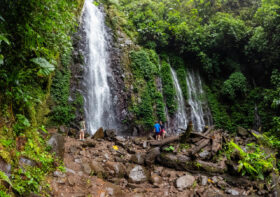Attraction spotlight: visit a Rideau Canal lock station
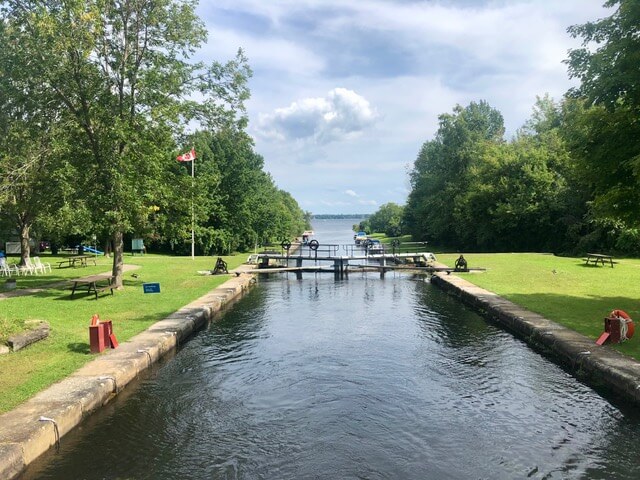
In this post, I wrote about our family trip exploring the Rideau Canal National Historical Site by houseboat. It was the perfect balance of heritage and nature. We boated along marshland and rivers, bird-watched and swam with fish. We hiked and biked along the waterway and explored quaint historical towns. (Honestly, the kids would have been happy had we gone nowhere, as long as they got to stay in the houseboat!)
But one of the most fascinating attractions of the trip was navigating the locks themselves. Watching boats passing through the Rideau Canal locks is mesmerizing in and of itself. Actually getting our houseboat through the locks was truly the highlight of our entire trip. We got to not only see, but experience a part of history.
What are the Rideau Canal locks?
The Rideau Canal is a river navigation system over 200km long that connects Ottawa to the St. Lawrence River. It uses two rivers, lakes, and 19km of human-made waterway. The canal system was completed in 1832. There are a total of 47 locks (give or take a few added/removed over the years). The Canal was built as part of Canada’s military strategy, then became a commercial waterway. It is now used mostly for pleasure craft and is a UNSECO world heritage site.
The Rideau Canal system is now operated by Parks Canada. The locks operate as a series of 24 lock stations (as some of the locks are grouped in 2 or 3s).
There are eight locks in Ottawa city proper, and can easily been seen when visiting Parliament Hill. There are also a group of locks in Kingston, at the opposite end of the Canal. But it’s worth a drive along Highway 15, between the two cities, to see some of the lock stations off the road. You can stop to admire the view, watch the boats (if there are any passing through), have a picnic. Some lock stations allow you to camp overnight. Lock stations may have picnic tables, water fountains, BBQs, washrooms, or little tourist centres. You can find information about each lock station here.
Even better, rent a houseboat, and explore the locks by water!
… What are “locks”?
The simple mechanics of lock navigation totally makes me nerd out. I have visited the Rideau Canal a number of times since I was a child. I took science class. But I never really *got* how locks work until I had to navigate through one myself. The idea and look of river locks might seem kind of boring, but it’s really not.
Basically (and I’m the last person in the world who should be giving a physics lesson), locks are like elevators for boats. They let boats navigate from high ground to lower ground and vice versa. It is basically a chamber with two gates on either side.
If I were a boat going from HIGH –> LOW: I go through one gate into the chamber, which is full of water that is level with the HIGH river. The gate closes. Water then flows OUT through the second gate into the LOW river. As water in the chamber empties, my boat lowers. Once the water in the chamber is level with the LOW river, the second gate opens and my boat is free to go.
If I were going to LOW –> HIGH: I’d drive my boat through the first gate into an almost empty chamber. The gate closes. Water pour IN from the second gate. The water level rises and my boat does as well, until I’m level with the HIGH river. Then the second gate opens, and bam! my boat hath risen.
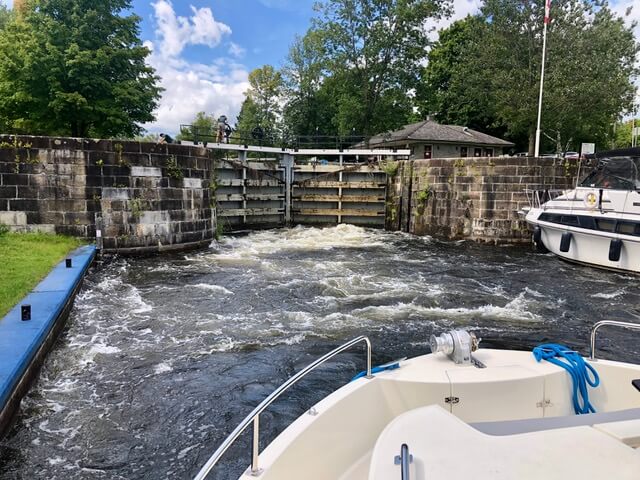
Okay, that is the only physics 101 I am ever going to give.
If you have kids, we have a waterway set that they set up on our patio, and it’s great! It’s not only good for water play on a hot day, but it’s a very hands-on way of learning about locks, pumps, and waterwheels. We have the Aquaplay Play-n-Go set, but they make a number of fun ones!
Rideau Canal lock stations quick guide:
Is there a fee?
There is no fee to visit the lock stations. There is a fee for overnight camping, and nominal lock fees and permit fees for mooring/launching if you bring your own vessel. If you’re renting a houseboat, the fee is calculated into the overall rental cost. Visit Parks Canada for updated information.
Can I visit the locks any time of the day?
You can, but the locks are only staffed during daytime hours. This is usually from 9-10am until 5-7pm, depending on the day and the season. If you are in a boat looking to pas through, most locks will ask that you arrive at least 30 mins before closing. Some lock stations that have a combination of 2-3 locks will ask that you arrive 2 hours before closing.
It is possible to camp at some of the lockstations. As far as I know, all of the lock stations allow overnight mooring of boats.
The lock stations are closed between mid-October to mid-May, but the locks are open for visitors. (Exercise caution around any water structure in icy conditions, of course.)
Are all the locks the same?
No! Each lock station has a complete different look and feel. Some are more manicured, with well maintained lawns, stairs and bridges. Some are more wild, surrounded by woods. The locks in Kingston and Ottawa city proper have a completely different feel. Many locks are maybe 2-3m in height, but some can be almost 20, combined. Taller locks are more dramatic!
Which ones you see may come down to which are more convenient for you. If you are renting a boat, you will pass a number of them, of course. If you are driving, I would suggest you choose to stop at at least 2-3 different ones. We stopped at Jones Falls on our way back from our boat trip, and it’s considered one of the prettiest lock stations. There is a large stone dam at the top point, and a large lake perfect for picnicking or watching fish.
Why is this such a neat experience?
Some of these lock stations are in picture perfect locations. They’re surrounded by woods, and with the meandering river, the stone locks and wooden lock gates, the historical stone houses of the Lockstation masters, it can almost be a scene right out of a storybook fairytale.
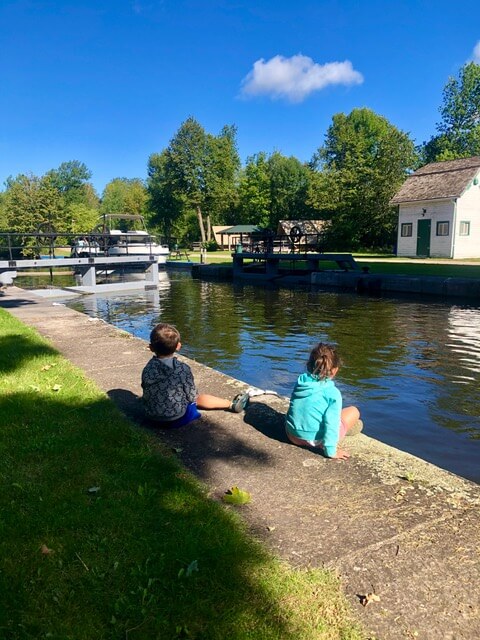
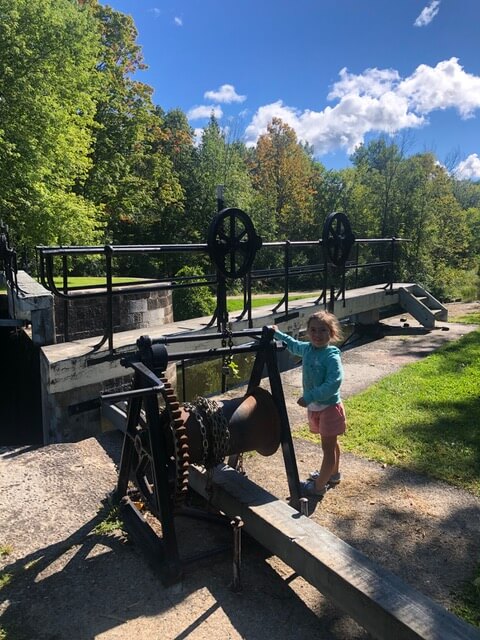
When the locks are not in use, it feels peaceful and serene. But it’s fascinating to see the locks in motion. These are working locks, from the 1830s! The gates are attached to pulleys, and a staff uses a large metal crank to pull the gate open. It’s an incredible feat of ingeniously simple and effective engineering. And yet still, when the water starts pouring in or out of the lock, and you hear and see the rush of the river set free, you can’t help but marvel at the incredible power of nature.
Exploring locks by water
If you get the chance, I strongly recommend renting a houseboat on the Rideau Canal. Besides the incredible time to be had (as detailed here), navigating the locks by boat is an entire other level of experience.
Our houseboat staff helped guide us through our first lock, but the first lock we had to navigate on our own was nerve-wracking. I can’t remember what I was freaking about more, that we were going to crash the boat into the sides or another boat, or that the kids were going to fall into the water while Daniel and I managed the boat.
Easy as 1, 2, 3…
As it turned out, taking a boat through a lock is pretty easy to do. The Parks Canada staff are also incredibly helpful. If you’re considering renting a boat on the Rideau Canal but feel as terrified as I did about navigating it, just remember it is only three manageable steps:
- approach the gate: if open, drive on into the lock. If closed, pull up to the side with the BLUE line and moor the boat. Wait patiently until the gates open and the staff gestures you in.
- park your boat on the right side of the lock, and secure it (I don’t know if there’s a technical term for this?) There will be cables along the sides of the locks that you can wrap your own ropes around, to keep your boat from drifting as the water levels change. For a houseboat sized vehicle, you will need TWO people, one at either end.
- once the water level has reached the desired level, release your boat from the cable, wait for the gate to open, and you are good to go!
It requires some work, sure, but getting to do it, and using the equipment from the 1830s was such a novel experience. And on the river, not only do you see and hear the rush of water (especially pouring IN to an empty, echoing chamber), you feel it, too. It is very powerful.
If you’re making a visit to Canada’s capital, or to the historical city of Kingston, I strongly suggest a stop at a Rideau Canal lock station. Even better, make a trip out of it.
Have questions about the Rideau Canal lock stations? Drop us a note!


